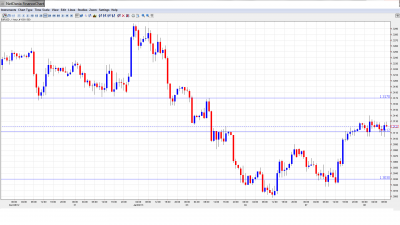The EUR/USD edged higher on the news that Japan plans to purchase bonds from the ESM in order to help weaken the yen and also improve financial stability in Europe. The pair has climbed back above the 1.31 line. After a quiet day on Monday, there are a host of Eurozone releases today. German Trade Balance plunged to a ten-month low, and Eurozone Retail Sales also fell below the estimate. The Eurozone Unemployment Rate remained unchanged, at 11.8%.
EUR/USD Technical
- Asian session: Euro/dollar edged higher, touching 1.3140, before consolidating at 1.3117. The pair is unchanged in the European session.
- Current range: 1.3110 to 1.3170.
Further levels in both directions:
- Below: 1.3110, 1,3030, 1.30, 1.2960, 1.2880, 1.28, 1.2750, 1.2690, 1.2624, 1.2590, 1.25 and 1.2440.
- Above: 1.3170, 1.3240, 1.3290, 1.3350, 1.34 and 1.3480.
- On the downside, the pair is testing 1.3110. The next line of support is 1.3030.
- 1.3170 remains a strong line of resistance.
Euro/dollar edges higher after Japan says it will purchase ESM bonds – click on the graph to enlarge.
EUR/USD Fundamentals
- 7:00 German Trade Balance. Exp. 15.4B. Actual 14.6B.
- 7:45 French Trade Balance. Exp. -4.8B. Actual -4.3B.
- 9:00 Italian Unemployment Rate. Exp. 11.2%. Actual 11.1 %.
- 10:00 Eurozone Retail Sales. Exp. +0.3%. Actual 0.1%.
- 10:00 Eurozone Unemployment Rate. Exp. 11.8%. Actual 11.8%.
- 11:00 German Factory Orders. Exp. -1.4%.
- 15:00 US IBD/TIPP Economic Optimism. Exp. 46.3 points.
- 20:00 US Consumer Credit. Exp. 12.9B.
For more events and lines, see the Euro to dollar forecast
EUR/USD Sentiment
- Eurozone Data Disappoints: We may have started a new year, but there hasn’t been much of a change in Eurozone data. After some disappointing PMIs last week, German and French Trade Balance looked weak. The German data was awful, as the indicator fell to 14.6 billion euros, well below the 15.4B estimate. The French numbers were better, with a deficit of 4.3B. The estimate stood at -4.8B. Unemployment remained very high, with the Italian unemployment rate down a notch to 11.1%, and the Eurozone rate stuck at 11.8%. For any recovery to get on track, these kinds of numbers will have to improve. The euro did not react to the data, but more bad economic news will certainly hurt the volatile currency.
- Japan announces it will purchase ESM bonds: Japanese Finance Minister Taro Aso stated on Tuesday that Japan plans to purchase bonds from the European Stability Mechanism, which is the Eurozone’s bailout fund. The ESM will begin issuing bonds immediately. This will be the first time that the ESM has issued securities since it was formed last October. Aso said that the move will help bring more stability to the Eurozone, which in turn will also help stabilize the yen and other currencies. Japan has already purchased about 7 billion euros from the European Financial Stability Facility (EFSF). Both bailout funds will run in parallel until the EFSF is phased out later in 2013.
- Markets shrug off US data: The markets were not impressed with last week’s US employment data, although the numbers were not bad. Non-Farm Employment Change rose to 155 thousand, which was slightly above the estimate of 150K. The Unemployment Rate edged up from 7.7% to 7.8%. However, the November rate was revised to 7.8%, so there was actually no change. ISM Non-Manufacturing climbed to 56.1 points, its best reading since March. This easily beat the estimate of 54.2 points. EUR/USD has not reacted to this recent data, and with only one key US release this week, the Eurozone releases will have added significance.
- Fiscal cliff averted, but trouble ahead: Following the last-minute agreement on the fiscal cliff, the markets breathed a collective sigh of relief. However, the euphoria could be short-lived, as the deal fails to deal with two critical issues – the debt ceiling and spending cuts. The debt ceiling will be reached in February, and action will have to be taken to avoid a default on the country’s debt. Otherwise, the real possibility of a US default will likely cause turmoil in the markets. Republicans are expected to demand cuts in programs such as Medicare and Social Security, while the Democrats vehemently oppose any reductions in these programs, and favor raising the debt ceiling, which is what Congress agreed to in 2011. The IMF has also weighed in, saying that the fiscal agreement does not go far enough and that the US must take further action to deal with its long-term debt problem.
- Eurozone debt crisis takes toll on bank lending: The Eurozone debt crisis has had a major impact on the continent’s banking sector. This dire situation has led to a sharp drop in the amount of bank loans to private households. Such loans dropped by 0.8% in November compared to a year ago, after a similar decline in October. The ECB is clearly worried, and blames this trend on weak confidence in the Eurozone economy and increased aversion to risk. Analysts expect credit demand to continue to be weak, and note that the ECB’s decision to cut its deposit rate to zero percent has not boosted bank lending to the private sector. On the flip side, the Eurozone M3 indicator, which measures the amount of money in circulation, jumped by 3.8% in November. This could be an indication that more inflation is on the way in 2013, which could affect interest rates and the value of the euro.

